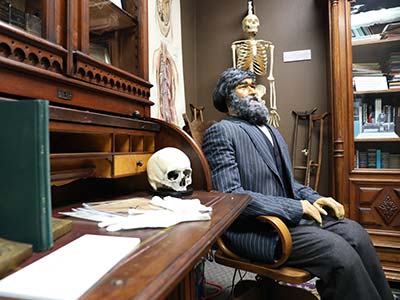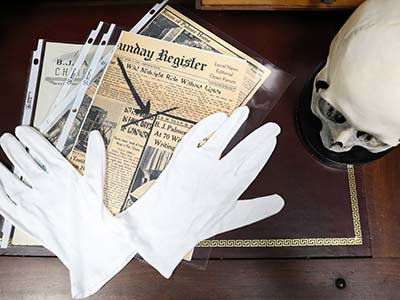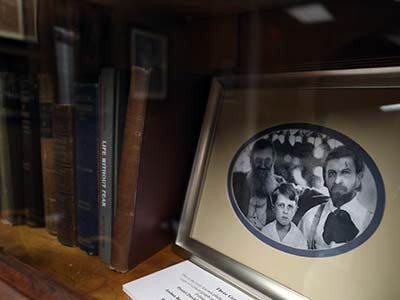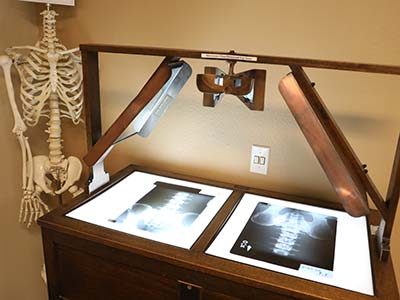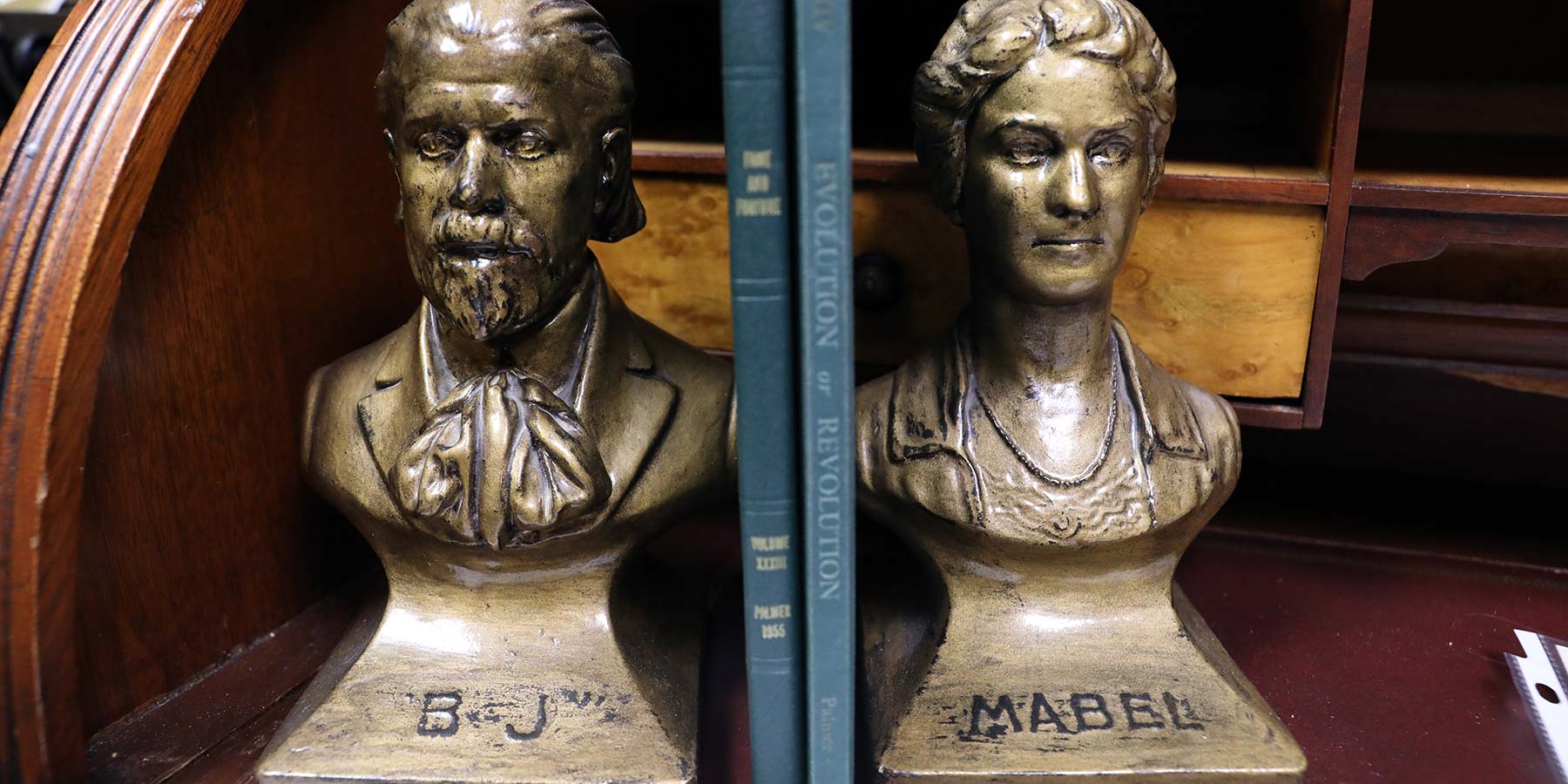
Life West’s museum, which opened in 2016, is home to an abundance of notable chiropractic artifacts carefully selected by Dr. George Casey, curator of the museum and a member of the Life West faculty for more than 30 years.
“Chiropractic has a rich and colorful history and, unless its story is told and displayed through the collection of its artifacts, much will be lost or left in the writings of history books,” Dr. Casey said.
As we prepare to celebrate the 125th anniversary of chiropractic, the museum offers the perfect opportunity to look back at the astonishing journey chiropractic has taken.
One of the prized possessions of the Life West History Museum is a manuscript donated by Life West President Ron Oberstein, DC, consisting of about 500 handwritten pages by Milly Reaver, wife of Dr. Herbert Ross Reaver. Called “the most arrested chiropractor,” he endured multiple stints behind bars as he sought to continue to practice.
The Journal of Chiropractic Achievers wrote in 1989 about Dr. Reaver’s mission to create a license for chiropractic. He told the local press at the time of his repeated arrests, “I am fighting for a principle, and someday I hope to see the Ohio law changed so that those engaged in practicing chiropractic will get a fair deal.” Dr. Reaver eventually was successful in helping to change the laws, and he later held a position as vice president of the International Chiropractors Association.
The museum also houses more than 400 books, and Dr. Casey said the goal is to collect every chiropractic book that has been published, which he estimates at 2,000 books. Examples on display in the Life West museum include the “green books,” which are among the first textbooks written about chiropractic. This collection of 39 numbered volumes got its name from their green binding and vine-patterned endpaper. The first “green book” was written in 1906 by D.D. Palmer, the founder of chiropractic. Other volumes were written by B.J. Palmer, known as the developer of chiropractic, his wife, Mabel, and many of the faculty of the Palmer College in the first half of the 1900s.
Visitor favorites include adjusting tables that date to the early 1900s. Two upper cervical adjusting tables in the museum are from Dr. George Anderson’s office. He was the founder of Pacific States Chiropractic College, which later became Life West, and he practiced upper cervical chiropractic care in Hayward, California following his graduation from the Palmer College in 1954. Many artifacts in the museum were donated by Anderson’s family, and an exhibit of historical mementos that documents his life includes a photograph of Dr. Anderson receiving a Humanitarian Award from Ethiopian dignitaries Adebe Kabebe, Administrative General, and Haile Selassie, Imperial Majesty and Emperor of Ethiopia, during the first World Chiropractic Congress meeting in Montreaux, Switzerland in 1970. Dr. Anderson was instrumental in the formation of the World Chiropractic Congress.
Also among the museum’s photographs is an impressive Mastodon Atlas vertebra. “One photograph shows Dr. Charles Ward posing as though he is attempting to adjust the vertebra, being held by Dr. Kirby Landis and Dr. James McCann, donor of the photograph,” Dr. Casey said.
Tools of the trade
The museum is also home to some special chiropractic tools, such as the Stereoscopic X-ray viewer that one can peep through, and an endocardiograph which records and graphs the sound and movement of a heart, so that rhythm, rate, and tone can be analyzed. The instrument was developed by Royal Lee in 1934, and restored endocardiographs are still being utilized. There are also two neurocalometer heat-sensing instruments on display. Dr. Casey notes that the instrument donated by the Anderson family has a very early serial number. Since Dr. Anderson and B.J. Palmer had become close friends, the family thought it may have been one of B.J. Palmer’s personal instruments.
B.J. Palmer, a pioneer in chiropractic, wrote what he called “epigrams” on walls throughout the Palmer College of Chiropractic campus in Davenport, Iowa. By the 1950s he had painted more than 3,500 epigrams on campus walls. “Each was designed to stimulate one’s thinking. Many are motivational and meant to inspire,” Dr. Casey said. During the women’s suffrage movement, for example, he painted a large message on the campus chimney. One side reads “Votes for Women,” and the other side reads “Equal Rights.”
Most of the original epigrams at Palmer College were painted over after B.J. Palmer’s death in 1961. “The history of the epigrams is now told through photographs of the college and various publications such as the green book, Volume XXVIII, Answers and As a Man Thinketh. Many of the epigrams were also published on cards and could be purchased individually or in packs. The museum has 35 examples displayed in a single frame,” Dr. Casey said.
Perhaps the only epigrams that survived are those that are still on the walls of several elevator shafts on the Palmer College campus. An epigram in one of the shafts reads, “We must learn right-thinking as we learn to sing, for right-thinking comes to us as does correct speaking—by training.”
Dr. Casey said, “The epigrams had been painted in the shaft because the original elevator allowed them to be seen through the metal cage as it carried its passengers up and down the four floors of the building.” A few photos of these last remaining B.J. Palmer epigrams are also part of the museum’s collection.
D.D.’s office
The museum’s largest exhibit is a replication of D.D. Palmer’s Davenport, Iowa office, complete with a life-size, animated replica of D.D. Palmer himself, sitting in a chair. Walking into this exhibit is like taking a trip in a time machine. The D.D. Palmer animatronic mannequin tells stories about his role in the history of chiropractic. In a video about the museum, Dr. Casey said, “We purchased the animatronic D.D. Palmer because we wanted to highlight the founder of the chiropractic profession.” Dr. Casey said he believes this is the only museum where you can visit D.D. Palmer in his office and hear him speak.
One of Dr. Casey’s favorite parts of the museum is an intricate 22-foot long mural that depicts the early history of the profession, starting with D.D. Palmer’s first adjustment in 1895. The mural showcases the development of chiropractic and some of the people who were important to the growth of the profession.
“Each year, the chiropractic profession makes tremendous strides in education, research and the practice-based evidence that advance its scientific acceptance and public credibility,” said Dr. Casey on the future of chiropractic. He also highlights the importance of the past: “There is much to learn from chiropractic’s colorful and eventful history that will enable the profession to build a stronger and more effective future for itself and those it serves.”
Read more about Life West in our online magazine!


